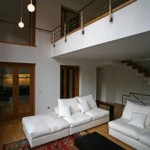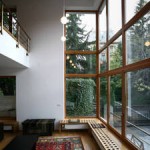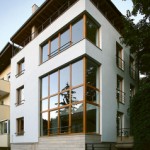Photo: Andrei Margulescu, Mihai Dutescu
The title already says quite a lot about this house. Without considering any pictures or plans, let’s try to make an imagination exercise: how would any of us design, if we were to do it, a house next to the Metropolitan Palace (the siege of the Romanian Patriarchy)? It would be an architecture discreet enough not to aggress such a vicinity, humble, we would refrain from free gestures, maybe someone up in the skies would draw our attention, or – on the contrary – we would actually search for a contemporary expression, up to something deliberately contrasting and contradictory. Or maybe it would be a little bit of all, for the wisest ones.
Built on an almost impossible site, of 86 sq. m., the house we are presenting hereunder displays first of all a very urban presence. It sustains an urban front – that which remained undemolished from the neighborhood around the Metropolitan Hill. At the same time, this house could look strange for the recent Bucharest architecture, which – in the best case – seems to endlessly reiterate the neo-modernist idiom, the same typologies, the same image (actually altered as to the 30’s original), the same details and materials; in the end, the same block-houses. This time yet, a house displaying a completely different nature.
Right beside the old ensemble, this house takes its resources from the Balkan architecture, the urban vernacular, from a relatively dense tissue, with a compact street cornice, picturesque, white, clothed in smooth slopes, with eaves coated with wood, with foyer, small windows, with interior sitting places displayed all along the windows, and so on. Besides, completely atypical materials and details compared to everything that we currently see being built: copper skins, with similar chutes, gargoyles and pipes, massive oak wood for the interior, “real” details, with cu bung and notch, brass railings, or stairs lacking any railing, double height living directly facing the opposite palace, woolen carpets, and partially rustic, partially modern furniture, icons and a wonderful collection of religious seals, which remind of Horia Bernea’s interiors from the Romanian Peasant Museum. Overall, an incredible atmosphere, hard to describe by images or words, so close to the city center.




